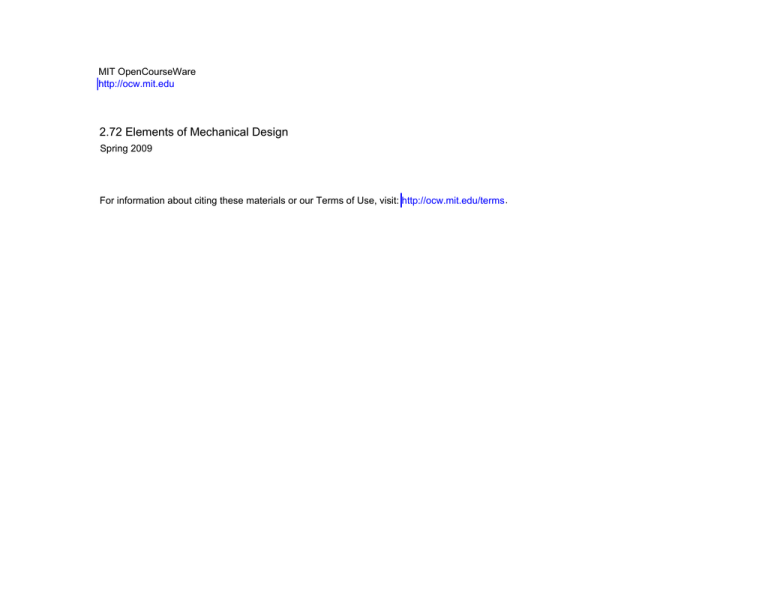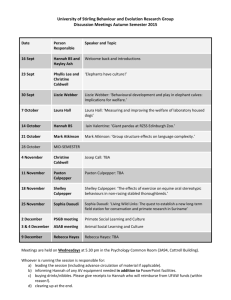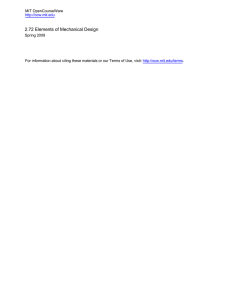
MIT OpenCourseWare
http://ocw.mit.edu
2.72 Elements of Mechanical Design
Spring 2009
For information about citing these materials or our Terms of Use, visit: http://ocw.mit.edu/terms.
2.72
Elements of
Mechanical Design
Lecture 06: Constraints
Schedule and reading assignment
Quiz
Quiz – HTMs
Topics
Principles of exact constraint
Bearing layout exercises
Spindle shaft constraint/bearing layout
Reading assignment
Chapter 11 in Shigley and Mischke
• Read sections 11.1 – 11.6, 11.9
• Skim sections 11.7 – 11.8, 11.10 – 11.12
This is 40ish pages, but most of it is pictures/graphs/examples
© Martin Culpepper, All rights reserved
2
Principles of
exact constraint
Under, exact and over constraint
Constraints are fundamental to mechanical design
A mechanical designers goal is to control, i.e. to constrain, parts so that
they are where they are supposed to be.
Exact constraint:
There should be one constraint for each degree-of-freedom that is
constrained.
Under constraint
Too few constraints, part is not held in all the directions it needs to be
Over constraint
Too many constraints, some constraints may fight each other when
trying to do the same job.
© Martin Culpepper, All rights reserved
4
Mechanical constraints
We want to learn how to model and design each
We first need to know:
How they should be used
What their functional requirements are
How they should be used and their FRs depend upon:
How they are laid out
Dos and don’ts
Learn to lay them out right
Use this to obtain their Functional Requirements
Then do the detailed design of each
© Martin Culpepper, All rights reserved
5
Constraints and Degrees-of-freedom
Rigid components have 6 degrees-of-freedom
We will represent an ideal constraint as a line
6 – C = R
C = # of Non-Redundant Constraints
R = # of Independent Degrees of Freedom
Example:
6 - 2constraints = 4DoFs
Rz
Courtesy John Hopkins, MIT
© Martin Culpepper, All rights reserved
6
Constraints, compliance and motion
Exact constraint: Achieve desired motion
By applying minimum number of constraints
Arranging constraints in correct constraint topology
Adding constraints only when necessary
y
z
x
Ground
For now:
Stage
Start with ideal constraints
Considering small motions
Constraints = lines
Focus on rigid stage attached to ground
What do we mean by rigid?
What do we mean by constraint? - Stiffness ratios
© Martin Culpepper, All rights reserved
7
The benefits of exact constraint
Y
X
Parts of machines are now
always the same strength and
stiffness.
A
Large, stiff components have a
tendency to “kill” their smaller
counterparts when they are
connected so that they are
forced to fight.
B
Loose
Exact constraint design helps to
prevent fights, therfore all your
parts live in harmony.
A
Binding
B
Figure by MIT OpenCourseWare.
Penalties for over constraint
© Martin Culpepper, All rights reserved
8
Constraint examples
y
More examples:
1
2
3
4
5
6
© Martin Culpepper, All rights reserved
z
x
9
Exact constraint
practice
Mechanical constraints: Some bearing types
Sliding
Bushings
etc…
Radial rolling
Radial
Shallow groove
Deep groove (Conrad)
Angular contact
Tapered
© Martin Culpepper, All rights reserved
11
Examples drawn from your lathe
© Martin Culpepper, All rights reserved
12
Example: Carriage constraint
y
z
x
Assume these are
bushings as in
your lathe
© Martin Culpepper, All rights reserved
13
Example cont.
y
z
x
Misalignment
& assembly
errors
© Martin Culpepper, All rights reserved
14
Example cont.
y
z
x
Thermally
Induced
growth
© Martin Culpepper, All rights reserved
15
Practical embodiment
y
z
x
Flexure that is stiff in y and z, yet compliant in x
© Martin Culpepper, All rights reserved
16
Group exercise – Carriage constraints
Identify the motions that you desire for the carriage and
the minimum # of constraints that are needed to yield
only these motions.
Identify the constraints from each bearing set and
determine how they act in concert to yield the desired
motions.
© Martin Culpepper, All rights reserved
17
Constraint layouts
and
thermal stability
Avoiding over constraint
How to deal with the thermal growth issue
The shaft typically gets hotter than the housing because the housing has
better ability to carry heat away
Whether the outer or inner race are fixed, matters…
Constraining front and rear bearings
One bearing set should be axially and radially restrained
The other bearing set should ONLY have radial restraint
Housing
Gear
Nut
Gear
Shaft
10.0 All rights8.0
© Martin Culpepper,
reserved
Tool
Chuck
Part
4.0
0
19
Examples: Good or bad
Outer race fixed axially, if shaft heats is this bad?
Think about what happens to the preload…
Housing
Chuck
Shaft
© Martin Culpepper, All rights reserved
20
Examples: Good or bad
Outer race fixed axially, if shaft heats is this bad?
Think about what happens to the preload…
Housing
Chuck
Shaft
This is the
back-to-back config.
It should be used
when the outer race
is not rotating
© Martin Culpepper, All rights reserved
21
Examples: Good or bad
Assume the outer
race does not rotate
1
Housing
Sliding permitted
Gear
Nut
Spacer
Gear
Chuck
Shaft
© Martin Culpepper, All rights reserved
22
Examples: Good or bad
Assume the outer
race does not rotate
2
Housing
Sliding permitted
Gear
Nut
Spacer
Gear
Chuck
Shaft
© Martin Culpepper, All rights reserved
23
Examples: Good or bad
Assume the outer
race does not rotate
3
Housing
Gear
Nut
Gear
Chuck
Shaft
© Martin Culpepper, All rights reserved
24
Examples: Good or bad
Assume the outer
race does not rotate
4
Housing
Gear
Nut
Gear
Spring
© Martin Culpepper, All rights reserved
Chuck
Shaft
25
Examples: Good or bad
Assume the outer
race does not rotate
5
Housing
Gear
Nut
Gear
Chuck
Shaft
© Martin Culpepper, All rights reserved
26
Examples: Good or bad
Assume the outer
race does not rotate
6
Housing
Gear
Gear
Chuck
Shaft
© Martin Culpepper, All rights reserved
27
Examples: Good or bad
Assume the outer
race does not rotate
Good
Front set constrained radially and axially
Rear set constrained only radially
1
Housing
Sliding permitted
Gear
Nut
Spacer
Gear
Chuck
Shaft
BUT, sliding means some gap must exist and therefore
one must precision fabricate if a small gap is desired
© Martin Culpepper, All rights reserved
28
Examples: Good or bad
Assume the outer
race does not rotate
Bad
Front set constrained only radially
Rear set constrained only radially
2
Housing
Sliding permitted
Gear
Nut
Spacer
Gear
Chuck
Shaft
This design will not work if axial loads are to be applied
along both directions
© Martin Culpepper, All rights reserved
29
Examples: Good or bad
Assume the outer
race does not rotate
Good
Front set constrained radially and ½ axially
Rear set constrained radially and ½ axially
3
Housing
Gear
Nut
Gear
Chuck
Shaft
BUT, adding a spring increases part count/cost
Axial stiffness values (left vs. right) will be different
© Martin Culpepper, All rights reserved
30
Examples: Good or bad
Assume the outer
race does not rotate
BAD
Front set is constrained only ½ axially
Rear set is constrained only ½ axially
4
Housing
Gear
Nut
Gear
Spring
Chuck
Shaft
This design will not work if axial loads are to be applied
along both directions
© Martin Culpepper, All rights reserved
31
Examples: Good or bad
Assume the outer
race does not rotate
BAD
Front set is constrained ½ axially and radially
Rear set is constrained ½ axially and radially
5
Housing
Gear
Nut
Gear
Chuck
Shaft
At high speeds/loads, thermal growth may kill the
bearing sets
Like a double face-to-face…
© Martin Culpepper, All rights reserved
32
Examples: Good or bad
Assume the outer
race does not rotate
Bad
Front set constrained radially and ½ axially
Rear set constrained radially (if flexure is of proper stiffness)
6
Housing
Gear
Gear
Chuck
Shaft
Left bearing set is not in the back-to-back configuration
Shaft can pop out…
© Martin Culpepper, All rights reserved
33
Group exercise
Group exercise – Spindle constraints
The spindles you have seen use tapered roller bearings. First, sketch a layout from one of the previous lathes
and diagnose its layout
Second, generate and sketch a different way to
constrain the spindle shaft.
© Martin Culpepper, All rights reserved
35



